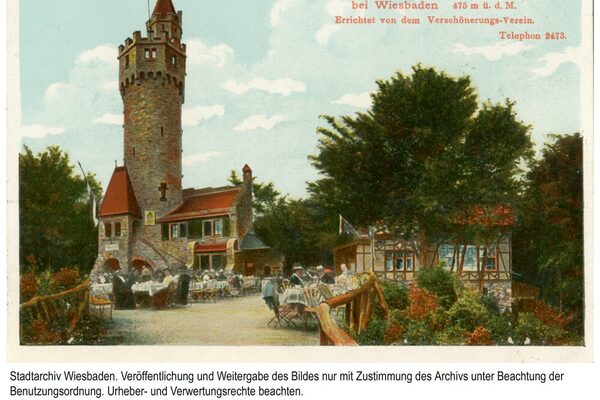Wiesbaden Beautification Association
In 1856, a number of citizens, including Dr. Wilhelm Zais, Adam Schmitt from the Zur Rose inn, the sculptor Prof. Fritz Gerth, H. L. Freytag from the Zum Bären inn and the building contractor W. Rücker, decided to found a beautification association. Hermann Vollpracht, a respected Nassau civil servant, was elected as the first chairman.
In accordance with the main purpose set out in the articles of association, which was to make the natural beauty of Wiesbaden's surroundings accessible in a planned manner, the Verschönerungsverein improved existing paths, installed signposts, erected a large shelter on the Neroberg and set up benches at scenic points along the footpaths. Wilhelm von Heemskerck, President of the Ducal Chamber of Finance of Nassau, took over the chairmanship from 1859-83, followed by Administrative Director Friedrich von Reichenau (1884-1900), Prof. Dr. Heinrich Fresenius (1901-02), Building Councillor Ernst Winter (1903-08), Master Builder Blume (1909-10) and, from 1911, pensioner Josef Hupfeld.
During this time, the Verschönerungsverein accomplished many tasks, e.g. the construction and maintenance of footpaths, driveways and avenues. In 1881, the total length of newly laid footpaths amounted to 40 km. The beautification association set up 400 benches, installed over 300 path signs, erected shelters and alcoves and planted 1,000 trees. In 1903, several board members of the Western District Association joined the Wiesbaden Beautification Association in order to work on the joint efforts. In 1913, it had the highest number of members at 1,166, including many well-known personalities from politics and business.
After the First World War, attempts were made to maintain what had already been created and to add a modest amount of new things. Due to the incorporation of the suburbs, an agreement was reached with the similar associations in Biebrich and Sonnenberg on joint activities and on including the other suburbs in the work. The jubilee hut on Philosophenweg was inaugurated for the 75th anniversary in 1931. After the forced dissolution of the Westlicher Bezirksverein in 1934, the Verschönerungsverein took over the association's assets, the huts and benches for further care.
At the beginning of 1937, the Verschönerungsverein was awarded the Wiesbaden city plaque for its services, but in 1938 it too was forced to merge with the Kur- und Verkehrsverein due to the guidelines of the Reichsverband für das Verkehrsgewerbe. On January 10, 1938, the general assembly unanimously decided to dissolve the association after 81 years of existence. The association's assets and the obligations arising from its work were transferred to the Kur- und Verkehrsverein.
